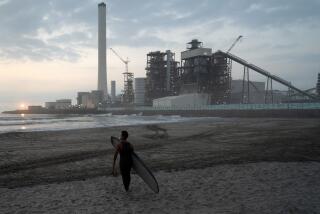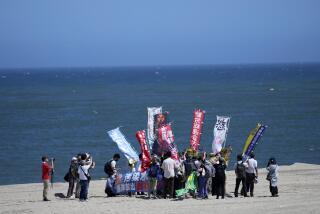Medical Progress Offers Hope for Japan Radiation Victims
- Share via
TOKYO — Advances in medical treatment for radiation victims give hope that one or more of the three workers severely irradiated last week in Japan’s worst civilian nuclear disaster could survive, doctors said Monday.
Two of the men received more than lethal doses of radiation Thursday after being bombarded with neutrons during an uncontrolled nuclear fission reaction at a uranium processing plant, and they remained critically ill Monday. But their condition was stable enough that doctors announced plans to give them both transfusions of bone marrow cells using new, noninvasive techniques pioneered on cancer patients.
Both Hisashi Ouchi, 35, and Masato Shinohara, 39, were continuing to suffer from a disastrous decrease in their ability to produce blood cells, among other problems. However, in an improvement on traditional bone marrow transplants, which were tried with little success on victims of the 1986 Chernobyl nuclear accident, Japanese doctors planned to give Shinohara a transfusion of blood cells from the umbilical cord of a newborn, a technique that avoids the rejection problems common with bone marrow transplants.
Ouchi was scheduled to receive a transfusion Wednesday of stem cells--immature blood cells that can develop either into red or white blood cells or into platelets and that would be harvested from his brother.
Most stem cells live in bone marrow, but small quantities circulate in the blood supply. In this new technique, called peripheral blood stem cell transplant, the donor takes a drug that increases blood cell production and then gives blood from a vein.
The stem cells are separated out and given to the recipient, while the rest of the blood is returned to the donor. The procedure is no more painful than giving blood, so neither the donor nor the recipient requires a general anesthetic--a big advantage for weakened recipients like radiation patients.
Moreover, the stem cells from peripheral blood start producing white blood cells in the recipient in about two weeks, whereas cells transplanted from bone marrow take three or more weeks to produce these leukocytes. Meanwhile, the immune-compromised patient is at high risk for potentially lethal infections, explained Dr. Hisamaru Hirai, a transplant specialist on the team that is treating Ouchi at Tokyo University Hospital.
“If we succeed, it would be the first time in the world” that a stem cell transplant has been used to help radiation victims, Hirai said. The technique has been used for about 10 years to treat victims of lymphoma and breast and lung cancer, who typically have the stem cells removed from their own blood and then reintroduced after chemotherapy or radiation treatments.
Other doctors and radiation specialists said that a better understanding of the physiology of radiation poisoning gained from the Hiroshima atomic bombing, Chernobyl and other disasters has helped improve treatment for the victims of the uranium processing plant disaster in Tokaimura, about 80 miles northeast of Tokyo.
In addition, there have been advances in the creation of truly germ-free hospital rooms, infection prevention, intravenous nutrition, life-support systems and methods for maintaining the body’s electrolyte balance, said Dr. Shunichi Yamashita of the Atomic Bomb Disease Unit at the Nagasaki University School of Medicine.
Yamashita went to Chernobyl, in northern Ukraine, 13 years ago and treated severely burned patients there. He said that if Ouchi and Shinohara had been similarly injured at Chernobyl, they probably would not have survived.
Twenty-eight people exposed to high radiation levels at Chernobyl died in the immediate aftermath of the accident. Twelve of those received bone marrow transplants, but all rejected the transplanted cells. Another victim also rejected the transplant but survived anyway.
The question is whether any of the Japanese patients’ own bone marrow has survived, American experts said Monday. If it has, it will reject the grafted cells. In cancer therapy, all of a patient’s bone marrow cells are normally killed before the transplant to prevent such rejection, but the Japanese men are already too sick for such a procedure.
Even if the grafts are rejected, however, they could help the men fend off infections until their own bone marrow recovers, said Dr. Rodney Withers of UCLA.
Yamashita said: “If Ouchi survives, it would be close to a miracle. But Japanese medicine can do miracles--I hope.”
Japan has a poor reputation in emergency medicine, and leading specialists have publicly chastised both the government and the medical profession for allowing patients to die because of slow transportation and lack of well-trained emergency medicine practitioners. But in this disaster, the emergency medical response was excellent, with three severely injured men quickly taken by helicopter to be treated by radiation experts at the National Institute for Radiological Science in Chiba prefecture, said Yamashita.
Doctors can only estimate how much radiation Ouchi and his colleagues actually received, because in one of the numerous safety violations that have emerged day after day since Thursday’s accident, the men were not wearing badges designed to keep a constant tally of their radiation exposure.
Authorities searching the plant for evidence Monday found the badges about 160 yards from the room where the workers were dumping buckets of high-grade uranium into a tank instead of piping the uranium solution in gradually through monitors, as the nuclear-fuel-producing facility was supposed to do.
Experts have estimated that Ouchi received about 17 sieverts of radiation; Shinohara, about 10 sieverts; and their supervisor, Yutaka Yokokawa, 54, about three sieverts. Seven sieverts is considered a lethal dose, although some victims of the 1945 U.S. atomic bombing of Hiroshima died after receiving just two sieverts, said Dr. Nobuo Takeichi, a radiation specialist there who also has helped treat child radiation victims from Chernobyl.
Yokokawa did not lose consciousness and has been interviewed by police from his hospital bed.
“I think he will probably live,” said Dr. Hideo Tanaka, a hematologist at the Research Institute for Radiation Biology and Medicine at Hiroshima University. “In today’s medical environment, though his hair will fall out and his leukocytes will drop, in a month they will probably bounce back. So he probably will not need a bone marrow transplant.”
Other specialists concurred with this prognosis, but all warned that infection is the most immediate danger for all three men.
At least 43 other people were also contaminated by Thursday’s accident, including three firefighters, other workers at the plant owned by JCO Co. and seven other people working at a construction company next door to the plant, some of whom said Monday that they did not know of the accident until they saw a TV news report about it 2 1/2 hours after it occurred. They stayed indoors but were contaminated nevertheless, according to Japanese media reports.
Authorities haven’t said how much radiation the 43 others were exposed to, but a Science and Technology Agency spokesman said Monday that the worst affected were cleanup workers, who nevertheless received less than 0.1 sievert, and that none has exhibited any symptoms of radiation sickness.
Takeichi said symptoms usually occur in people who get doses of 0.25 sievert or more.
Ouchi and Shinohara initially suffered nausea and diarrhea and slipped in and out of consciousness, but by Monday those symptoms had passed. Ouchi’s doctors said he was conscious and responsive and not complaining of pain.
His brother was already taking the drug that will stimulate blood cell production and the release of more stem cells into the bloodstream in preparation for Wednesday’s transplant. If the stem cells from the first day proved inadequate, the transfusion could be repeated each day for several days, Hirai said.
However, Ouchi’s white blood cell count continued to plummet Monday, and he was suffering from pulmonary edema. His platelet count was less than half the normal level, and if it dropped further, he might also require a platelet transfusion, his doctors said. Gastrointestinal bleeding could also develop, they warned.
Shinohara does not have a relative who can offer him a good bone marrow match, and that is why he was considered a better candidate for the umbilical cord blood cell transplant, doctors said. The problem with the procedure is that the volume of blood, and hence stem cells, in the umbilical cord might not be adequate for an adult. Shinohara was transferred to Tokyo University Hospital on Monday evening in an antiseptic tent, but a date for his transplant had not been announced.
Guarded though their statements were, the medical team--and the Japanese people who are following their daily briefings--were clearly heartened that all three men were still alive.
“If they can survive more than one month after the blood transfusions, it is very, very promising,” Yamashita said.
Times staff writer Thomas H. Maugh II in Los Angeles and Chiaki Kitada and Hisako Ueno of The Times’ Tokyo Bureau contributed to this report.
(BEGIN TEXT OF INFOBOX / INFOGRAPHIC)
Radiation Treatment
The worst-affected Japanese radiation victims have suffered a severe decrease in their bodies’ ability to produce blood cells. One victim will receive blood cells from the umbilical cord of a newborn. Another will receive a transfusion of stem cells from his brother.
The stem cells are immature blood cells that can develop either into red or white blood cells or into platelets.
Source: Dorling Kindersley Ultimate Visual Dictionary
More to Read
Sign up for Essential California
The most important California stories and recommendations in your inbox every morning.
You may occasionally receive promotional content from the Los Angeles Times.










